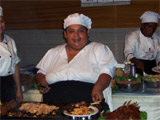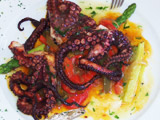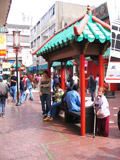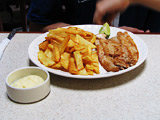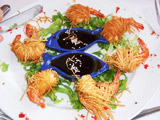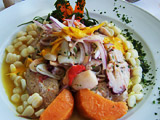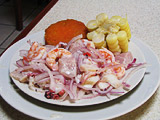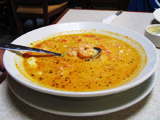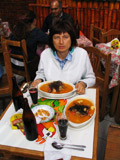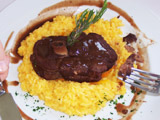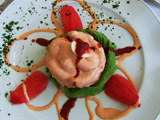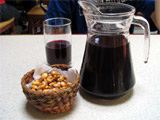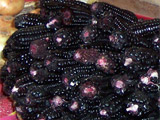|
Peru is a country of gourmands
| |
Irina Nazarova (February, 2006) |
|
South American country Peru is interesting not only because of its history and culture, but cookery as well. The Peruvians are great specialists in this field, in which connection they are not only good cooks but they love it. One may say that cookery is a national asset of Peru.
It is visible even before the first visit to the Peruvian restaurants: a great number of restaurants, cafes, “eating houses” of different directions and level immediately catches eye at the streets of Lima. Besides it there is a number of cookery courses, books and magazines. And any respectable newspaper either prints recipes or has supplements with those.
The Peruvian cuisine is a successful baby of two great cultures – Hispanic and Andean. Variety of local products – potatoes and other root vegetables, corn, tomatoes, avocado, alpaca meat and many others – acquired new pallet range with imported by conquistadors olive oil, lemon and garlic. African slaves and Arab cooks, who had accompanied the Spaniards, had a hand in it too.
The distinctive feature of the Indian cuisine is that it had not only the nourishing but healing purpose as well. Indians had no spices that were willingly used by Spaniards, instead they used a lot of aromatic and medical herbs, as well as dozens of varieties of hot pepper – aji. There is also an interesting peculiarity – Indians did not use either eggs or milk, as they treated with trepidation the natural cycle of birth and feeding the breed. In some remote areas of the country they still cook purely Indian dishes using original ingredients, the odor of which could be described by nobody but only J.K. Jerome.
Black slaves introduced many methods of cooking the giblets, as, of course, they could never get pure meet.
To my opinion the restaurants of Lima can be divided in 4 large groups: fish (cevicherias), Creole cuisine (Cocina criolla), national (the majority of which are Chinese – chifas), and international, to my mind, featureless, as a rule, expensive and not very tasty.
As I have already written the majority of restaurants in Lima are Chinese chifas, starting with the cheapest ones, where one can have dinner for 2-3 dollars, up to exquisite and rather expensive, such as “Royal”. The Chinese came to Peru in the second half of the 19th century, mainly from Canton province. Nowadays the Chinese colony in Peru counts almost half a million inhabitants. The same way as in any respectable megapolis Lima has its own Chinese residential area. Chinese cooks found fertile soil for their masterpieces in shape of excellent seafood, vegetables and herbs. Some gourmands think that Chinese cuisine in Lima is more tasty than in China itself. The Chinese introduced the tradition to use rice by all layers of society, practically with any dish.
Owing to specific climatic conditions, including cold stream Humboldt, the coastal zone of Peru is one of the richest in seafood and fish. In such conditions Japanese restaurants can't but please gourmands. Large scale Japanese immigration to Peru was marked about 100 years ago, basically from Okinawa. Unlike Chinese, Japanese colony counts only 100 thousand people. It produces great social and gastronomy influence on the Peruvian culture. For example, the Japanese transformed traditional “el cebiche” into “el tiradito”. In fact it is one and the same thing, only in cebiche the fish is cut in cubes and tiradito consists of its flat slices – just like in sashimi.
It is cebiche – the most popular Peruvian dish that should be the first to describe the national cuisine. The Peruvians themselves perceive cebiche not just like a mere food, but as a national symbol. Historians, anthropologists and sociologists still argue about the origin of this dish and its correct spelling. Cookery experts as well as common housewives keep on looking for the ideal way to cook it. But there is one main prerequisite observed by everyone: the fish must be the freshest, preferably with white dense meat. And the lemon must also be Peruvian – small, green, with bitter sour taste. Basically such breeds of fish as lenguado, charela, corvina, mero and cojinova are used to cook cebiche. But of course any hostess (or a host) can use the fish, which seems suitable. For example in Mexico I cooked good cebiche using the shark meat (but it has to be marinated for a couple of hours), and in Moscow I found nothing better than the Norwegian salmon. There is also a variety of cebiche made from different seafood – shrimps, octupi, various sea shells. Cebiche mixto is the most popular dish among our fellow countrymen. But here I would like to share the classic recipe of don Cucho – one of the most competent cooks of the country.
Cebiche
- 600 gr of lenguado fillet;
- 20 lemons;
- hot pepper (aji limo);
- red onion;
- 4 leaves of green salad (lechuga);
- 4 cubes of ice;
- sugar, salt, anise to taste;
- corn ear;
- camote.
Cut fillet in 2 cm cubes, slice the onion into thin rings, wash everything twice in cold water. Boil the corn in water with sugar and anise. Boil camote in skins.
Rub the inner surface of glass bowl with a piece of hot pepper, place fish and onion, add ice and salt. Squeeze enough lemons to cover ¾ of the fish and onion with juice. Mix everything for 30 seconds.
Spread out salad leaves in a soup plate, top them with fish, finely cut pepper may also be added if you like it hot. Put corn and sliced camote next to it.
Bon appetit!
Those, who will cook cebiche in Moscow, in absence of green lemons (or if their cost is enormous), I can advise to use concentrated lemon juice, which is sold almost everywhere and can successfully replace real lemons. Well, and you can easily do without camote. Try and you will not regret!
Another peculiar feature of the Peruvian cuisine – is a great variety of soups. In my own experience in other Latin American countries first courses are not very much popular, but here in every restaurant, especially fish restaurant, you can taste at least a dozen of delicious soups: chupes, aguaditos, sudados (there is no use to translate their names, they should be perceived as they are) and others. These can be both some lean soups and very rich, practically the second courses and mashed potatoes.
But one of the most popular first courses is parihuela – soup with different seafood, including fish. As a rule it is served in a huge “basin” decorated by a crab hand and sometimes by a whole crab in the wreath of seaweed (edible, by the way). Popularity of parihuela can be partially accounted for the faith of the Peruvians that seafood enhance sexuality. It is quite possible, but as for me after so heavy a dinner I feel sleepy.
Curious situations also occur. In Trujillo (north of Peru) in a restaurant I ordered a local dish – sopa teologa. You can imagine my surprise, when instead of soup they brought a huge dish with a big piece of kid, rather large chicken leg and very rich garnish of some unknown to me cereals.
In fact those who plan to visit Peru should be warned that generally the dish in the restaurant is meant for very good eaters. In our family everybody has an average appetite, that is why in our favorite cebicheria we always take two dishes for two. For example, half cebiche and half chupe de camarones. That is why I advise to start with one dish, most likely, it will be quite enough.
Creole cuisine is very nourishing – various meat, giblets, dish of potatoes, cereals and corn flour. It is linked with influence of slaves – the meal should be inexpensive, but nutritious. The typical dish is anticuchos – little shashliks of beef heart. In traditional restaurants you can try both habitual to us mutton, veal, chicken and exotic meat of llama and “siu” - guinea-pig. Our favorite pets are bred specially for food, their meat is very tender and dietary. As long as the Peruvians have not seen anything unusual in this delicacy, even the fresco “Last supper” in the San Francisco abbey features a dish with a guinea pig in front of Jesus.
And at last, one can't help but speaking about another national pride of the Peruvians – potatoes. According to one of the Inca legends, when the founders of the nation Manco Capac and Mama Ocllo came out of Titicaca waters, the first thing that they learned from the chief god Wiracocha was the art of growing potato. The Peruvians count almost 4000 varieties of this root and consider its age to be about 8000 years. The most important, at the end of the last year it was scientifically and officially proved that Peru was the motherland of potato. This news was happily welcomed as the Chileans keep on trying to deprive the Peruvians of that honor. On May 30 the Peruvians even celebrate the national day of potato.
4000 kinds of potato can hardly be tasted by anyone, but in any local supermarket you can find up to 10 varieties that differ in size, colour, shape and purpose. The Peruvians can cook potato dishes not worse than we do, but they store it not only in its natural state but also in dried one. Dishes, made of this potato are called carapulcra. Beautiful, isn't it? Names of many dishes can be recited as verses: el tacu tacu, la pachamanca, la chanfainita, el sancochado.
Coming back to potato I would like to say that I have never tried more tasty French fries as in Peru. In any restaurant it is cooked equally well. Whether the Peruvians are such experts or the product is of such good quality.
But what feast can be without a sweet course?! The Peruvians have also succeed in this. Besides, comparing with other Latin American countries, Peru is a sweet country. The most important thing is that they can cook really tasty desserts here, but not merely sweet. Marvelous are various cakes and pastries, mousses and flans, rolls and cheesecakes. You can enjoy familiar to everyone tiramissu or “black forest” (selva negra) and if you wish – exotic mousse of maracuya. I liked the latter so much, that I started to make it at home, since it is very easy to make. I will share the recipe. The only trouble in Moscow is that I have never seen maracuya in Moscow stores, and even it appears, probably it will be too expensive for an average person. But I think that the exotic juice can be replaced by any local juice, but it should be sour. Red currant will probably perfectly “sound” in this dessert.
Maracuya mousse
- teaspoonfull of granulated gelatine;
- a packet of queso crema;
- a tin of condensed milk;
- a cup of maracuya juice;
- one cup of cream (rich enough to be whipped).
Dilute gelatine in three spoons of water, warm it up in microwave till completely dissolved for about 40 seconds. Using mixer whip the quesa crema (grated cottage cheese) for several seconds, add condensed milk, juice and gelatine, continue to whip till homogeneous soft paste. Separately add whipped cream and carefully mix everything.
After that you can act according to your desire. You can put the paste into individual small bowls, put into refrigerator for one hour and then decorated with chocolate chips. Or you can take a bigger bowl, on the bottom of which you put a shortcake, top it with tasty paste, decorate with maracuya seeds and refrigerate overnight. And you will get a delicious cake, which will make your mouth water.
Sorry, I missed to tell you how to make juice. You cut the fruit in half, remove the inside with a spoon and put into a blender. Switch on to low speed and make sure the seeds remained whole and juice separated. Then drain the received mixture through the tea-strainer. Retain seeds to decorate the mousse, they appetizingly crunch in the teeth.
Well and the last touch – national beverages, which include pisco (another stumbling block with Chileans) and wine. The wine, naturally, in all respects loses to the Chilean one and I remain its faithful admirer (just don't tell it to the Peruvians). As far as pisco is concerned, only an admirer of grape vodka can take it neat, but pisco sour cocktail is not bad. Not long ago on January 4 the Peruvians celebrated the national day of pisco sour, and it really means something. We don't have a national vodka day, do we?
Among soft drinks one can single out Inka Cola – a yellow lemonade, resembling the Soviet soda “Buratino”, and, of course the Peruvian violet colour (as for me - it is black) corn (maize morado). The corn looks menacing, but the drink is very tasty.
Of course it is impossible to describe in few pages all the variety of the Peruvian cuisine, and the most important is to give the idea, how tasty and appetizing it is all, but someone may develop a desire to personally partake of all delicacies, which can be found in this wonderful country. Welcome!
|


